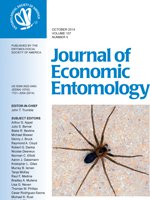Asiatic rice borer, Chilo suppressalis (Walker), larvae cause extensive crop losses worldwide. Because chemical control is problematic, and sex pheromone applications are a valuable management tactic in China, judicious timing of a minimal density of pheromone dispensers is important in developing a cost-effective C. suppressalis IPM program. During June–October in 2011, 20, 30, 40, and 50 dispensers per hectare for mass trapping, and 200, 300, 400, and 500 dispensers per hectare for mating disruption were placed in northeastern China rice fields. Based on those results, only the two highest mass trapping densities were used in 2012–2013. The 40, 50, and 500 dispenser densities reduced egg masses to <2.0 per 100 tillers, compared with >9.5 in the insecticide-treated plots in 2011–2013. The reduced oviposition resulted in >85% reduction of larval damage, which was comparable with the currently used insecticides, dimethoate and deltamethrin (0.35 kg/ha), which gave no egg reduction, but ≈80 and 89% reduction in larval damage. The 40 and 500 densities are recommended to Chinese rice farmers for mass trapping and mating disruption programs, respectively.
How to translate text using browser tools
1 October 2014
Mating Disruption or Mass Trapping, Compared With Chemical Insecticides, for Suppression of Chilo suppressalis (Lepidoptera: Crambidae) in Northeastern China
Ri-Zhao Chen,
Michael G. Klein,
Cheng-Fa Sheng,
Qi-Yun Li,
Yu Li,
Lan-Bing Li,
Xing Hung
ACCESS THE FULL ARTICLE
It is not available for individual sale.
This article is only available to subscribers.
It is not available for individual sale.
It is not available for individual sale.

Journal of Economic Entomology
Vol. 107 • No. 5
October 2014
Vol. 107 • No. 5
October 2014
Asiatic rice borer
rice damage
rice stem borer
sex attractant
striped stem borer




